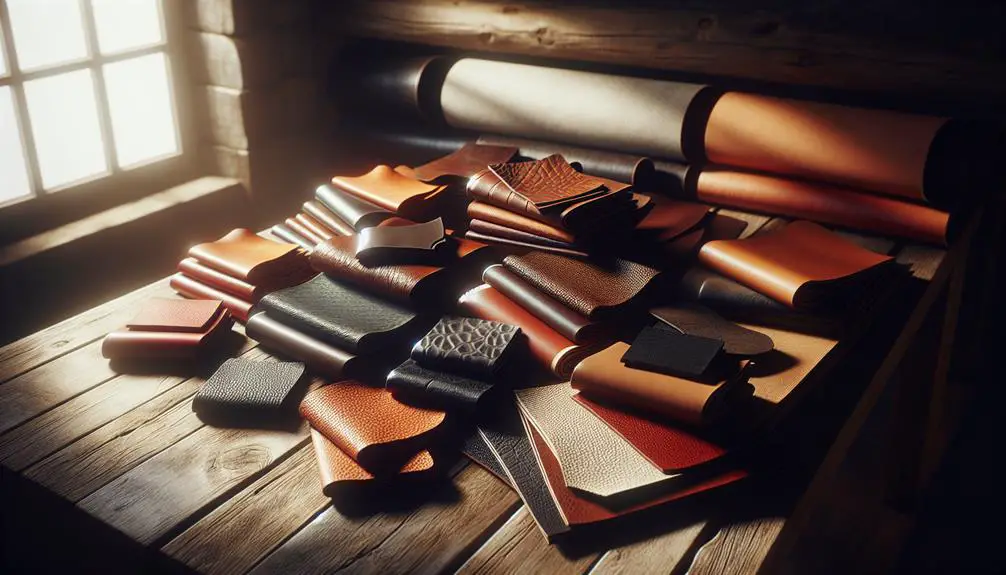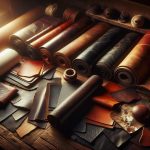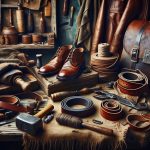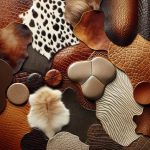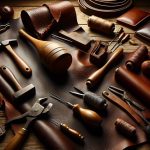High-quality leather, like full grain and top grain, stands out for its durability and unique natural features. Full grain leather incorporates the entire grain layer, showing all its natural textures and marks, which tells me it's completely authentic. It's the toughest kind, getting even more resistant and attractive with age thanks to its patina. Top grain leather is slightly refined to make it more flexible yet maintains high-quality traits. Both types are loved for their luxurious feel and minimal flaws, making them ideal for premium products. There's a lot more to discover about why these leathers are the top picks.
Table of Contents
Key Takeaways
- High-quality leather includes full grain and top grain, known for durability and natural aesthetics.
- Full grain leather retains the entire grain layer, enhancing durability and moisture resistance.
- Top grain leather offers a balance of affordability, smooth finish, and durability.
- Proper maintenance such as regular conditioning is crucial for preserving leather's appearance and longevity.
- Quality leather often comes from reputable sources like U.S. steerhides and gold-rated tanneries.
Defining High-Quality Leather
High-quality leather, such as full grain or top grain, is prized for its durability and distinctive natural features. These materials represent the pinnacle of leather craftsmanship, offering not just longevity but a true connection to the artisanal traditions of leather making. When I'm picking leather goods, I always look for full grain or top grain labels because they tell me I'm getting the best.
Full grain leather, the top tier in quality, includes the entire grain layer, untouched and natural. This means it hasn't been sanded or buffed to remove imperfections, which preserves the fiber's strength and durability. Top grain leather, while slightly altered, still maintains a high level of quality. It's a bit more pliable than full grain, which can be beneficial depending on the use.
Additionally, the rich, sweet smell of these leathers, thanks to the oils and waxes used during the tanning process, can really tell you a lot about their quality. It's these subtle cues that make all the difference. They aren't just materials; they're a narrative of quality, care, and authenticity that I deeply appreciate as a connoisseur and user of fine leather goods.
Characteristics of Full-Grain Leather
Let's explore what makes full-grain leather a top choice for durability and style.
I'll break down its long-lasting qualities, how it looks better with age, and the best ways to keep it in great shape.
Understanding these aspects can help you make informed decisions about leather products.
Full-Grain Durability Factors
Full-grain leather, renowned for its durability, retains the hide's natural characteristics and becomes even more resistant to wear over time. This type of leather develops a unique patina that not only enhances its appearance but also acts as a shield against wear. Its intact grain surface helps fend off moisture and reduces the risk of tearing, making it ideal for items that see a lot of use.
| Feature | Benefit |
|---|---|
| Natural Imperfections | Adds character, uniqueness |
| Intact Grain Surface | Increases resistance to moisture and tearing |
| Develops Patina | Enhances durability, aesthetic value |
I've come to appreciate full-grain leather's robustness, especially in my daily-worn boots and frequently used leather couch. Its quality is unmatched.
Aesthetic Appeal Variations
While I've highlighted the durability of full-grain leather, its aesthetic qualities are equally impressive. This top-tier leather boasts a luxurious, smooth surface with minimal flaws. The intact grain not only contributes to its stability and longevity but also ensures that full-grain leather develops a unique patina over time. This patina isn't just about looks; it adds a layer of protection while enhancing the leather's natural allure.
Full-grain leather often sports an aniline finish, which amplifies its natural beauty without covering its characteristics. This finish allows the leather to showcase its authentic texture and subtle imperfections, making each piece distinct. It's no wonder that full grain is a top choice for high-quality footwear and furniture.
Maintenance and Care Tips
To maintain the elegant appearance and durability of your full-grain leather items, regular conditioning is essential. Using a quality leather conditioner helps preserve the natural beauty and resilience of the material.
Full-grain leather, known for its robustness, also develops a unique patina that enhances its aesthetic value over time. By applying conditioner, you protect the leather from moisture and reduce the risk of stains.
Remember, the natural imperfections in full-grain leather add character, so treat these areas with care to maintain their authenticity. Regular care not only keeps your leather looking great but also extends its life, ensuring you enjoy its richness and texture for years to come.
Make conditioning a habit!
Benefits of Top-Grain Leather
Top-grain leather offers an ideal balance of affordability and durability, making it a popular choice for everyday leather goods. As someone who's always on the hunt for high-quality leather without breaking the bank, I've found that top-grain leather hits the sweet spot. It's less pricey than full-grain leather, yet it stands up well to daily use.
This type of leather is particularly suited for items like wallets, belts, and handbags, which undergo frequent handling. The reason is its enhanced stain resistance and the ability to hold up against wear and tear better than other lower-quality leathers. What's especially appealing is the smooth finish and suppleness it maintains, thanks to its sanded surface and finish coat. This not only makes it versatile for various styles and designs but also ensures it remains aesthetically pleasing over time.
Moreover, top-grain leather develops a patina as it ages, which isn't just about looks—it actually enhances the leather's durability and resistance to elements. This gradual enhancement of its character and strength makes it a smart purchase for anyone looking to invest in leather goods that age beautifully while retaining their practicality and protection.
Understanding Genuine Leather
Now, let's look at genuine leather and what makes it distinct.
We'll explore its various grades, understand its durability, and share some practical care tips.
This will help you make informed choices when purchasing leather products.
Genuine Leather Grades
Understanding genuine leather grades reveals that it's often seen as the lowest quality of real leather. Genuine leather, while still real, doesn't match the high standards set by full-grain or top-grain leather. It's made from the leftover pieces of the hide, which are then bonded together. This results in a product that lacks the strength and aesthetic appeal of higher leather grades.
Here's what you should know about genuine leather:
- It's more affordable than other leather grades.
- It's widely available in various product markets.
- It may not provide the same tactile or visual quality as higher grades.
For anyone looking to master leather quality, understanding these distinctions in leather grades is crucial.
Durability of Genuine Leather
Genuine leather, while affordable, doesn't hold up as well over time compared to higher quality leathers. It's the lowest grade of leather, made from leftover scraps. This means it often looks and feels less appealing. Also, it wears out quicker because it's lower quality.
When I'm considering leather products, I keep in mind that genuine leather is widely available and less costly. However, it lacks durability. It's important to understand these limitations. Knowing this helps me make smarter choices. If I'm looking for something that lasts longer, I'd likely skip genuine leather. It's crucial to weigh the quality against how much I'm willing to spend and how long I expect my purchase to last.
Care Tips for Leather
While genuine leather may not be the most durable, proper care can extend its lifespan significantly. Here are some key tips:
- Clean Regularly: Use a soft cloth to gently wipe your leather items. This removes dust and prevents build-up.
- Condition: Conditioning leather helps maintain its suppleness. Apply a quality leather conditioner every few months.
- Avoid Excess Water and Heat: Water can stain and damage leather. Keep it dry and away from direct heat sources which can cause drying and cracking.
Caring for genuine leather isn't just about keeping it looking good. It's about preserving the functionality and extending the value of your investment in high-quality leather goods.
The Role of Tanning Processes
The quality of leather heavily depends on the tanning process used. When we look at high-quality leather, the grain and texture tell a lot. One standout method is vegetable tanning. This traditional technique uses natural tannins from plants, enriching the leather with a unique character that synthetic methods can't match. Vegetable-tanned leather not only boasts a rich, natural color that ages beautifully but also maintains a strong, durable grain that withstands the test of time.
Other methods like chrome tanning are popular too. It's quick and cost-effective, making it a go-to for many manufacturers. However, it's not without its issues. The chemicals used in chrome tanning can be harsh on the environment, which is a significant drawback for eco-conscious consumers.
Combination tanning strikes a balance, blending techniques to enhance the leather's attributes. By selecting the right tanning process, manufacturers can tailor the leather's properties, such as its flexibility, water resistance, or texture, to suit various needs. Understanding these processes is crucial because they directly influence the look, feel, and durability of the leather. Each method has its place, but the key is in choosing wisely based on the desired outcome.
Importance of Leather Source
Understanding where leather comes from is crucial for assessing its quality and sustainability. When I'm considering a purchase, I always make sure the leather is made from real, high-quality sources. This not only assures me of the product's durability but also its ethical footprint.
Here are a few key points I consider:
- Origin of Rawhide: The best rawhide, often sourced from U.S. steerhides, is renowned for its superior quality. Knowing this helps me trust the product's durability and finish.
- Certification: I look for products sourced from Gold rated tanneries certified by the Leather Working Group (LWG). This certification is a guarantee that the tannery adheres to strict environmental protection regulations.
- Avoid Unregulated Sources: I steer clear of leather products from countries with less stringent or unregulated leather industries. This isn't just about quality but also about supporting practices that harm the environment.
Asking about the origin of the leather and ensuring it's sourced from environmentally conscious providers gives me peace of mind. It's not just about having a great product; it's also about supporting sustainable practices in the leather industry.
Identifying Leather Grades
When looking at leather, it's crucial to understand the different grades available.
I'll start by breaking down the types of leather grades and how they affect the quality of products.
This will help us assess what makes some leather goods better than others.
Types of Leather Grades
Let's explore the different grades of leather, each with its unique characteristics and uses. Starting with the highest quality, full grain leather is known for its luxurious, flawless surface and durability. It's ideal for products where longevity and aesthetics are key.
Conversely, bonded leather is at the lower end of the spectrum. Made from scraps and synthetic materials, it's less durable and prone to peeling.
Here are three key differences:
- Durability: Full grain lasts much longer than bonded.
- Appearance: Full grain develops a patina, enhancing its beauty; bonded does not.
- Cost: Bonded is cheaper due to its lower quality and shorter lifespan.
Understanding these grades helps in making informed choices in leather products.
Assessing Leather Quality
I often assess leather quality by closely examining the grade, which reveals the material's durability, appearance, and value.
Full Grain leather, known for its luxurious, smooth surface and intact grain fibers, stands as the highest quality. It's durable and ages well, making it a top pick for anyone seeking long-lasting products.
Just below this, Top Grain leather offers a balance of quality and flexibility. Its sanded surface and finish coat enhance durability while maintaining a good level of the original texture.
These grades are crucial indicators. When I look at these, I can immediately gauge how well a leather item will perform and how it might age over time.
Leather Maintenance Tips
To keep your leather looking its best, regularly clean it with a gentle leather cleaner. This simple step is crucial for maintaining both the appearance and longevity of your leather items, regardless of the leather quality or types of leather. I've found that a proper cleaning routine helps preserve the leather's natural characteristics and prevents premature aging.
Further, it's essential to hydrate your leather. Just like skin, leather needs moisture to stay flexible and smooth. Here's a quick list of steps I follow to keep my leather in top shape:
- Clean: Wipe the surface with a cleaner specifically designed for leather.
- Condition: Apply a high-quality leather conditioner to keep it supple.
- Store: Keep your leather items in a cool, dry place away from sunlight.
Common Leather Myths Debunked
Many people mistakenly believe that genuine leather is the highest quality, but it's actually the lowest grade available. This misconception often leads to confusion when choosing leather products. Genuine leather, while real, is made from leftover scraps bonded together, far from the premium feel of higher grades.
Another myth I've encountered is that the more uniform the grain, the better the quality. In reality, full-grain leather, which is the highest quality, showcases natural imperfections. These marks are proof of the leather's authenticity and durability. It's a common error to equate these unique textures with defects, when they actually add character and strength.
Furthermore, it's crucial to understand that high price tags don't always mean superior quality. While it's true that high quality leather typically costs more to produce due to its durability and natural aesthetics, not every expensive leather product is made from high-grade material. It's essential to feel the leather, noting its softness and pliability, to really judge its quality.
Future of Leather Industry
While debunking common myths helps clarify what quality leather is, looking ahead reveals a major shift in the industry towards sustainability and innovation. As someone deeply interested in the future of leather products, I've observed several transformative trends that are reshaping how we think about leather.
Firstly, the drive towards sustainable practices is paramount. Companies are now prioritizing methods that reduce environmental impact. This includes minimizing water use, cutting down on harmful chemicals, and decreasing waste. It's not just about making leather better; it's about making the process better for the planet.
Moreover, the rise of alternative materials is gaining momentum. Here are three intriguing developments:
- Bio-leather: Scientists are creating leather from microbial processes, which could drastically cut down on animal use.
- Lab-grown leather: This technology cultures animal cells specifically to produce leather without the need to raise and kill livestock.
- Plant-based sources: Innovations include deriving leather-like materials from mushrooms and pineapple leaves, offering a truly vegan option.
These advancements reflect a growing consumer demand for ethical, eco-friendly leather products. I'm excited to see how these innovations will continue to transform the leather industry, making it more sustainable and responsive to global needs.
Frequently Asked Questions
What Does High Quality Leather Mean?
High quality leather means it's durable, has a natural texture, and often comes from the top layer of the hide. It's more expensive but lasts longer and looks better over time.
What Are the 4 Grades of Leather?
The four grades of leather are full grain, top grain, genuine leather, and bonded leather. Each grade reflects a different quality and durability, crucial for making informed purchasing decisions.
How Can You Tell High Quality Leather?
To identify high-quality leather, I look for a soft, pliable texture with natural imperfections and a clear grain pattern. Higher price points often indicate better quality, reflecting more meticulous production processes.
What Is the Highest Level Leather?
The highest quality leather is Full Grain leather. It's renowned for its durability and ability to develop a unique patina, making it a top choice for luxury items like high-end shoes and furniture.
- How Does Ring Spun Cotton Affect Garment Fit and Shape Retention? - August 13, 2024
- What Are the Challenges in Producing Ring Spun Cotton? - August 13, 2024
- Is Ring Spun Cotton Suitable for Plus-Size Clothing? - August 13, 2024

